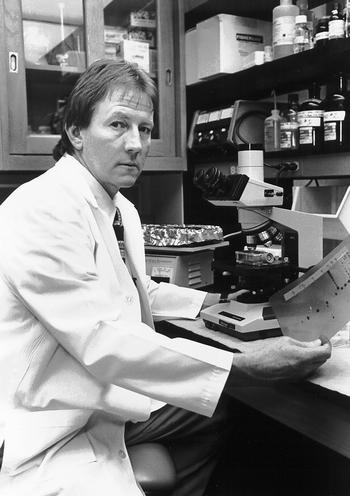New center formed to conduct research, treat endometriosis

Dr. Kevin Osteen is leading VUMC's endometriosis research efforts. (Photo by John Howser)
Vanderbilt University Medical Center is on its way to becoming a comprehensive research and clinical center in the diagnosis and treatment of endometriosis, a painful condition in women of reproductive age that often leads to infertility.
The multi-million dollar effort has a two-pronged approach the establishment of a National Institutes of Health-funded center for research in endometriosis and a research initiative sponsored by the Endometriosis Association in which Vanderbilt will serve as the primary North American research site.
"At Vanderbilt we are going to establish a research initiative directed toward endometriosis research with a focus on developing better therapeutic strategies for women with the disease," said Dr. Kevin G. Osteen, professor of Obstetrics and Gynecology.
"This combined research initiative funded by the NIH and by private foundation money will make us a comprehensive research and clinical center in the pathophysiology, diagnosis and treatment of endometriosis," he said.
Each of the endeavors is expected to begin in late spring or early summer. A kickoff will soon be held for the international fundraising efforts of the Endometriosis Association.
Endometriosis occurs when bits of the endometrium (the tissue that lines the uterus) are expelled from the uterus during menstruation and travel backward into the pelvic cavity, then become implanted on other pelvic organs. Most often the implants develop on the outside of the ovaries, the fallopian tubes, or the uterus.
The mislocated cells imitate the menstrual cycle, first thickening and then bleeding as menstruation begins. Because the implants are embedded within other tissue, there is nowhere for the blood to go. They form blood blisters that irritate the surrounding tissues, then a cyst is often created to encapsulate the blister. The cyst may become a scar or an adhesion. The end result may be infertility.
Osteen said the phenomenon of reflux menstruation (backward flow) is common among most women but why some women develop ectopic sites of growth is not known.
Although the exact cause of endometriosis is uncertain, it is believed to be a disease that has both an immunological as well as an endocrine component.
The exact number of women with endometriosis is not known because it is not easily diagnosed. A laparoscopy is needed to truly identify the disease process. But the total number of affected women is estimated to be about 10 percent of the reproductive age population. About 40 to 50 percent of women with unexplained infertility are subsequently found to have endometriosis.
There is also new evidence that suggests that environmental factors, especially in industrialized countries, have an impact on the disease process.
VUMC has already received a grant from the Environmental Protection Agency (EPA) to look at the effect of dioxin, a by-product of combustion, on endometriosis.
"In countries like Japan where they incinerate all of their trash, they have much higher levels of environmental contamination of dioxin and also higher levels of endometriosis," Osteen said. "The link between some of these environmental factors and the disease process is just now emerging. The cellular and molecular action of environmental factors is part of what we¹re investigating as a group."
Epidemiologic data suggests women are being diagnosed with endometriosis at a younger age.
"This is a troublesome finding that would provide us further impetus for trying to understand the role of environmental factors in this disease process," Osteen said. "If it¹s showing up in women in their early teenage years or in their early 20s, the potential impact on a woman¹s life is going to be that much greater."
Osteen said it is important to bring together as many scientists and disciplines as possible.
"We need an appropriate mix of scientists to investigate a complex disease process."
In addition to Osteen and his laboratory, other groups at VUMC that will be researching endometriosis are Gary E. Olson, Ph.D. and Loren H. Hoffman, Ph.D., professors of Cell Biology; Lynn M. Matrisian, Ph.D., professor and vice-chair of Cell Biology; David E. Ong, Ph.D., professor of Biochemistry; and Michael H. Melner, Ph.D., professor of Obstetrics and Gynecology.
Some areas that will also be investigated are growth factors and cytokines that act to affect both the endocrine system and the immune system.
"This broad-based approach will give us a better idea of the disease process that operates under the influence of both of these systems," Osteen said.
How endometriosis affects the establishment and maintenance of pregnancy will also be explored. Directing the clinical aspect of the research will be Dr. Esther Eisenberg, associate professor of Obstetrics and Gynecology.
"Our approach will be bench to bedside," Osteen said. "The focus of the group is to try to do as much translational research as we can in order to benefit the care of the patients as rapidly as possible."













